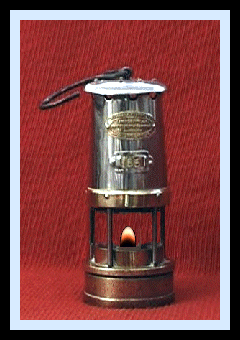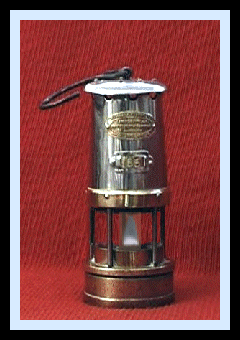PONTYPOOL GLYN PITS
Safety Lamp
In 1816 a safety lamp was invented by Sir Humphrey Davy. The working principle is quite simple, in that it relies on the cooling effect of copper gauze to cool any hot gases from the flame before they come into contact with mine air, which may contain gases such as 'Firedamp'. Davy used this principle by surrounding the flame in a lamp with copper gauze, copper being, next to silver, the best conductor of heat, and in the early lamps, there was no glass, so that the light from the oil flame was considerably reduced. In later types of lamp, the gauze cylinder was fitted only in the top part of the lamp body, called the 'Bonnet', with a thick glass surrounding the flame. Both gauze and glass were fitted with a gas-tight seal, and for safety purposes, the body of the lamp was arranged so that it could not be opened other than with the proper apparatus, usually either a magnetic lock or small padlock to secure the base from unscrewing. The safety lamp was also used for testing for gas underground. Fire-damp, or Marsh gas, being chiefly Hydrogen, is lighter than air, and so collects in cavities in the roof of a mine. By holding the lamp - which draws its air for combustion from the top of its casing, or Bonnet - up into a cavity, the size of a blue cap over the flame will, to a practiced eye, indicate the amount of gas present, as shown in the picture below. This picture is of a testing lamp, and the height of the gas cap varied with the amount of gas in the mine air, I.E the more gas the higher the cap.


The above lamp is a Galforth lamp used mainly for testing for gas
The lamp on the right shows what happens to the flame when gas is present while taking on the shape of a witch's bonnet and turning the colour of the flame blue.